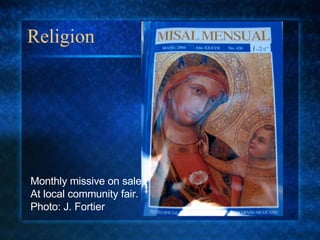Anth Ch12 Religion
•Als PPT, PDF herunterladen•
7 gefällt mir•2,248 views
Melden
Teilen
Melden
Teilen

Weitere ähnliche Inhalte
Was ist angesagt?
Was ist angesagt? (20)
Danny_Maribao_Lesson 11-religion-and-belief-systems

Danny_Maribao_Lesson 11-religion-and-belief-systems
Ähnlich wie Anth Ch12 Religion
Lesson 1 understanding the nature of religion

Lesson 1 understanding the nature of religionJustice Emilio Angeles Gancayco Memorial High School SHS
Ähnlich wie Anth Ch12 Religion (20)
Different Forms of Animism and Cults for Sociology Students

Different Forms of Animism and Cults for Sociology Students
Religion as an Anthropological ConceptScott E. Antes 1996-2009.docx

Religion as an Anthropological ConceptScott E. Antes 1996-2009.docx
Mehr von Jana Fortier
Mehr von Jana Fortier (15)
Kürzlich hochgeladen
young Whatsapp Call Girls in Adarsh Nagar🔝 9953056974 🔝 escort service

young Whatsapp Call Girls in Adarsh Nagar🔝 9953056974 🔝 escort service9953056974 Low Rate Call Girls In Saket, Delhi NCR
St. Louise de Marillac: Animator of the Confraternities of Charity

St. Louise de Marillac: Animator of the Confraternities of CharityFamvin: the Worldwide Vincentian Family
black magic specialist amil baba pakistan no 1 Black magic contact number rea...

black magic specialist amil baba pakistan no 1 Black magic contact number rea...Amil Baba Mangal Maseeh
🔝9953056974 🔝young Delhi Escort service Vinay Nagar

🔝9953056974 🔝young Delhi Escort service Vinay Nagar9953056974 Low Rate Call Girls In Saket, Delhi NCR
Kürzlich hochgeladen (20)
young Whatsapp Call Girls in Adarsh Nagar🔝 9953056974 🔝 escort service

young Whatsapp Call Girls in Adarsh Nagar🔝 9953056974 🔝 escort service
St. Louise de Marillac: Animator of the Confraternities of Charity

St. Louise de Marillac: Animator of the Confraternities of Charity
Understanding Jainism Beliefs and Information.pptx

Understanding Jainism Beliefs and Information.pptx
Monthly Khazina-e-Ruhaniyaat April’2024 (Vol.14, Issue 12)

Monthly Khazina-e-Ruhaniyaat April’2024 (Vol.14, Issue 12)
No.1 Amil baba in Pakistan amil baba in Lahore amil baba in Karachi

No.1 Amil baba in Pakistan amil baba in Lahore amil baba in Karachi
No.1 Amil baba in Pakistan amil baba in Lahore amil baba in Karachi

No.1 Amil baba in Pakistan amil baba in Lahore amil baba in Karachi
No.1 Amil baba in Pakistan amil baba in Lahore amil baba in Karachi

No.1 Amil baba in Pakistan amil baba in Lahore amil baba in Karachi
Study of the Psalms Chapter 1 verse 1 by wanderean

Study of the Psalms Chapter 1 verse 1 by wanderean
Dubai Call Girls Skinny Mandy O525547819 Call Girls Dubai

Dubai Call Girls Skinny Mandy O525547819 Call Girls Dubai
black magic specialist amil baba pakistan no 1 Black magic contact number rea...

black magic specialist amil baba pakistan no 1 Black magic contact number rea...
Amil baba in uk amil baba in Australia amil baba in canada

Amil baba in uk amil baba in Australia amil baba in canada
Topmost Kala ilam expert in UK Or Black magic specialist in UK Or Black magic...

Topmost Kala ilam expert in UK Or Black magic specialist in UK Or Black magic...
Asli amil baba in Karachi asli amil baba in Lahore

Asli amil baba in Karachi asli amil baba in Lahore
🔝9953056974 🔝young Delhi Escort service Vinay Nagar

🔝9953056974 🔝young Delhi Escort service Vinay Nagar
Unity is Strength 2024 Peace Haggadah_For Digital Viewing.pdf

Unity is Strength 2024 Peace Haggadah_For Digital Viewing.pdf
Anth Ch12 Religion
- 1. Religion Monthly missive on sale At local community fair. Photo: J. Fortier
- 8. Raji woman collects Yam ‘Mother’
- 10. Animism of the Pleiades: “The 7 Sisters” Animation of star Formations is Common across cultures
- 26. Location of Melanesian Cargo Cults • Part of Revitalization Movements
- 29. A New Age Number of Americans giving no religious preference grew from 7% to 13% between 1990 and 2001
- 32. Religious Composition (in Percentages) of the Populations of the U.S., 1990 and 2001, and Canada, 1991 and 2001
